The Most Exciting Work in Conservation Today May Be in China

Today is World Environment Day and it has me thinking of a question.
If you could go back in time and be a part of a historical event—not be an observer, but a real part—where would you go? A revolution, perhaps? Would you save lives in a disaster, or try to help head off a great historical wrong? Is there a time in our history that you are just a little bit jealous that you weren’t part of?
For many conservationists, I suspect they would choose the early 1970s (when NRDC, where I work, was founded). That was a heady time, with the first Earth Day and the beginning of the modern environmental movement.
But for me, I would go back farther—to the turn of the 20th century. The time of pioneering conservationists Teddy Roosevelt, Gifford Pinchot and, of course, John Muir. Back to a time when, after decades of industrialization and agricultural expansion, Americans realized the great gift that our remaining wild places, still vast and beautiful, offered future generations and determined to preserve them.
That’s when the United States passed the Antiquities Act, giving the president the power to establish national monuments, and Roosevelt moved to protect the Grand Canyon; when we passed the Migratory Bird Treaty Act and mourned the demise of the passenger pigeon; when titanic battles over the purpose of wilderness raged between John Muir and Gifford Pinchot; and when Aldo Leopold, still a young man in Wisconsin, watched the “fierce green fire” dying in a wolf’s eyes and started to think differently about the world.
It was a problematic time of course—deeply racist, sexist and anti-immigrant. Many of those “wild” places were, in fact, home to indigenous people whose rights were ignored. We should not forget, for example, that Yellowstone National Park was the home to the Tukudeka people. But it was also a time when many Americans began to believe in a broad, deep, and sustained way that we owed something to the natural world.
Right now, something similar may be happening in China. China is, of course, an ancient civilization with one of the richest and most sophisticated philosophical traditions in the world. The country that gave the world Lao-Tzu needs no lessons from the West about how to think about the natural world. But after decades of remarkable economic progress, China is embracing the concept of “ecological civilization,” which is meant to put ecological and environmental progress at the center of the government’s policy goals, and is beginning to reorder its government structures and ambitions accordingly.
Among other things, China has consolidated its natural reserves under a single body—China’s State Forestry and Grasslands Bureau—which will make it easier for the government to administer them. China also wants to create a new national park system by 2020 with the stated purpose of preserving areas of outstanding beauty and vital wildlife habitat.
One of the first of these new national parks will be the Tiger and Leopard National Park in northeast China. Bordering Russia and North Korea and spanning 3.6 million acres, or one-and-a-half times the size of Yellowstone, the park is home to some of the last forests where Siberian (also called Amur) tigers and Amur leopards still roam. These are incredibly rare species. Only about 500 Siberian tigers still exist in the wild, and about a dozen of those are thought to occur in China. And Amur leopards? Their number hovers at a mere sixty.
NRDC is assisting China as it thinks through how to structure and realize the new park (and the bigger park system in which it is embedded). You can read more about the park and our work here, here, and here.
On second thought, maybe I wouldn’t go back in time after all. Maybe I would stay right here and help China’s new national park system bloom.




